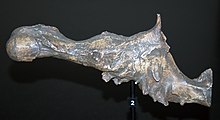Cranial cast

A skull cast or endocast (from English endocranial cast = cast of the inside of the skull (neurocranium)) is a spatial replica of the brain created naturally or artificially in the laboratory, especially in paleontology and paleoanthropology . The inside of the skull serves as a matrix . Since, among other things, the convolutions of the brain are imprinted on the inside of the skull, they are - conversely - also visible in an endocast. An endocast can therefore - as an almost lifelike image of the missing organ - provide information about the arrangement and size of individual areas of the brain.
Skull casts can be made in the laboratory, for example by filling a skull with plaster of paris. But they can also arise in nature, when a skull fills with sand and mud and the material later hardens and petrifies. Then it can happen that the skull bones decompose, but the skull spout remains as a fossil . More recently, “virtual skull casts” have also been produced with the help of computer tomography and other imaging processes , so that damage to the often valuable and sensitive skull bones is avoided.
Founder of the systematic analysis of fossil Schädelausgüssen which Paläoneurologie , to clarify questions of evolutionary biology , was Tilly Edinger (1897 to 1967).
Particularly well known is the 2.4 million years old natural Endocast the " child of Taung ," which is the fossil of an approximately three-year Australopithecus africanus , a pre-human , is. The analysis of the skull cast from fossil LB1 also plays a role in the ongoing scientific discussion about the classification of Homo floresiensis in the human family tree .
